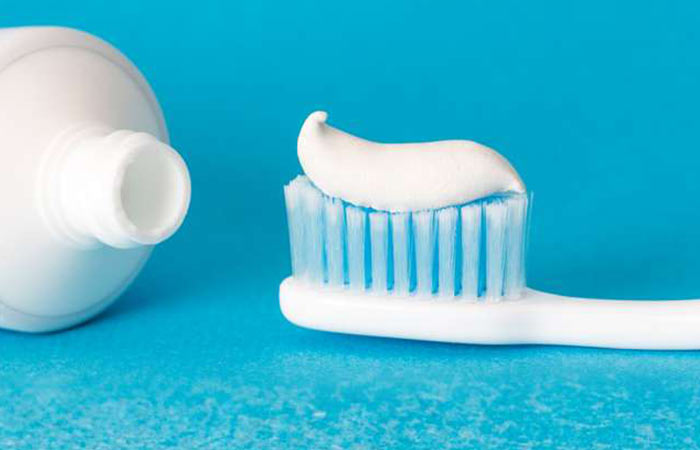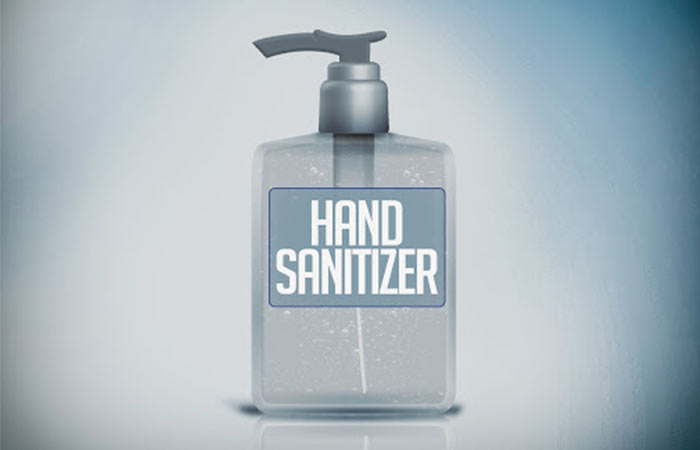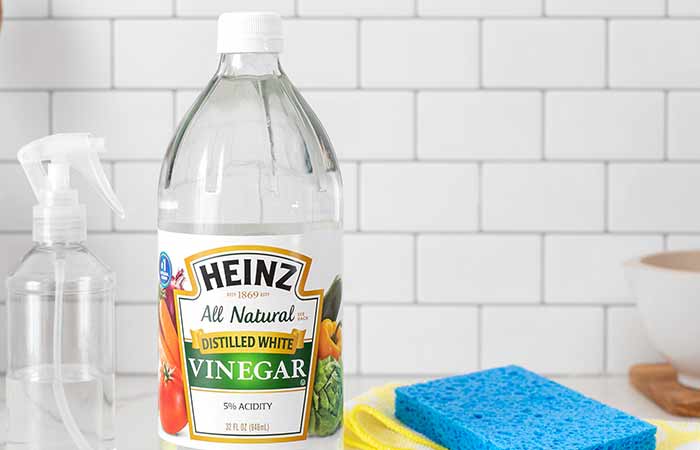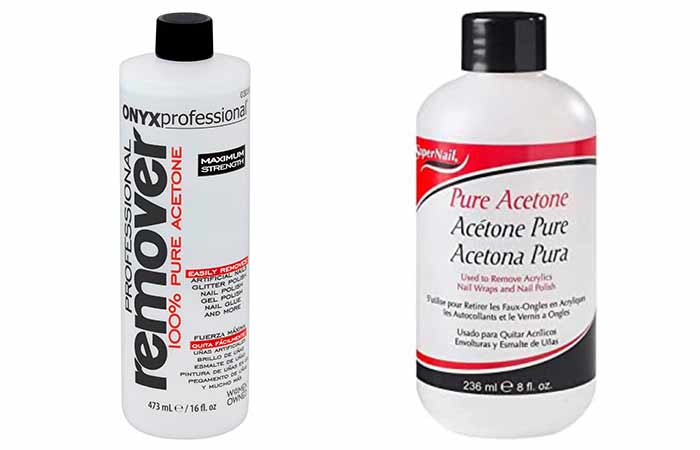How to Get Nail Polish off Skin-Without Remover & Naturally
Nail lacquer that has accidentally spilled and dried on skin is quite huge concern for many manicurists and the DIY fans who like to do their nails at home.
You can remove nail polish without a remover by using DIY options including toothpaste, sanitizer, or naturally using vinegar/warm water. You can as well use specialized acetone nail polish remover and cotton swabs.
Following are details on the various home acetone-free and acetone-based methods to get nail polish off your skin especially around nails.
Toothpaste
Toothpaste is a day-to-day household item that most of us won’t lack. The paste has ethyl acetate, an ingredient that is also common in some polish removers.

To use paste as polish remover, follow the steps below.
- Get the toothpaste of your choice
- Squeeze the paste onto an old brush or cotton swab.
- Scrub your nails and the other affected areas.
- Let the scrub sit for a few minutes
- Use a cloth to wipe your nail and check for any remaining polish.
Hand sanitizer
The pandemic has made hand sanitizers more popular than ever before. The alcohol in sanitizers softens the polish thereafter getting it off the skin.

Here are the steps to follow.
- Soak a cotton ball in the sanitizer
- Rub the affected with ball.
- Alternatively, soak your hands in the sanitizer for a few minutes then rub off the softened polish with a cloth and rub on the nails.
- Repeat till you get the results.
Remove Nail Polish Naturally with Vinegar & Lemon Juice

You can use white vinegar or a vinegar solution mixed with lemon juice to fight nail polish. Vinegar is an acid and used in doing various purposes around the house.
Therefore, it can be used in taking off nail polish from your skin. To improve its effectiveness, you should squeeze half a lemon or orange juice to get a powerful citrus cleaning power.
After mixing them rub the solution on the affected area the wait for about 10 to 15 minutes then try to rub the nail polish with cotton to remove it completely from the skin.
Warm Water and Dry Cloth
This is another natural way to get rid of nail polish color from your nails though you should be careful with the water temperature to avoid burning your skin.
Take some warm water in a bowl and put your fingers in it; once the old polis becomes soft enough you take out the fingers from the water and rub the nails gently with the dry piece of cloth.
Spray Deodorant/Perfume
Apply spray deodorant on your skin that is stained with nail polish in this case you should not use a deodorant which is in solid form as it will not have the same effect.
Then soak your skin that is stained with nail polish in water for two to three minutes which will thoroughly remove the deodorant and nail polish on your skin then apply a hand sanitizer on your skin to get rid of any deodorant remains and it will also remove remains of nail polish.
Regular perfume can also help you in removing your nail color from the nails or skin. You just dip a cotton ball or swab in a little amount of perfume and rub your painted nails or skin with it. This needs very little pressure to get of the nail color.
Hairspray
Some sprays have rubbing alcohol. Simply apply the spray on your nails and wipe off the spray with a piece of cloth. Repeat until you see results.
How Remove Nail Polish with a Remover (Acetone)
If the acetone-free methods don’t work or they take a lot of time…the remaining option is to use a nail polish remover.

When using acetone to remove nail polish from your skin you should follow the following steps:
- Get a bottle of acetone or nail polish remover keeping in mind that these products can be harsh and drying to your skin. They are therefore not recommended for small children or to those who have a very sensitive skin. Non acetone nail polish can work too but it is not very powerful like the acetone nail polish.
- Consider putting on some latex gloves if you just did your nails because any acetone or nail polish remover will destroy what you had just done. If you can’t find a cotton wool bud it might be a good idea to put on a pair of latex or plastic glove to protect your painted nails.
- Choose something to use in applying the acetone or nail polish remover with. For small areas a cotton ball will work better, but for larger areas such as your hands, arms and feet a towel will work best. If you just did your nails you should consider using a cotton swab; you can hold the cotton swab by one end and use the other end to polish it away.
- The next step is to moisten the cotton ball or towel with the acetone or nail polish remover. You only need the cotton ball or towel to be wet but not soaking or dripping. You can also squeeze out the excess moisture with your fingers.
- If you are using a cotton wool bud dip it into the acetone or nail polish remover and wipe any excess on the edge of the bottle.
- Rub the affected area until the nail polish comes off. If it does not resoak the cotton ball or towel again and rub again eventually the nail polish will come off.
- Finally rinse your skin with soap and water. If you have a sensitive skin you can treat the affected area with some hand cream, or lotion to help prevent any dryness.
Dealing with Nail Polish on Toddler Skin
Adult nail polish contains toxic chemicals which can be toxic to children when ingested, or when the child sucks or eats the nail polish. Toddlers can get nail polish from polished nails which are still wet and not dry. They can also get the nail polish if you do not keep it safely where your toddler cannot reach it.

They can also get nail polish from wet surfaces which are not cleaned after you have nail polished your fingers. Nail polish has some side effects to your toddler therefore affecting their health status.
There are various ways that can be used to get rid of the nail polish from their skin or nails which include:
Soaking the toddler in warm water and rubbing gently with a soft cloth. The skin has natural oils that will build up under the nail polish and it will rub off when soaked in warm water.
In case you do not have a nail polish remover use a rubbing alcohol in a cotton ball or wash cloth and place it on your child’s skin for a few seconds and then lightly wipe across the nail polish to loosen and dissolve it.
For nail polish on your toddlers face you should be careful when removing the nail polish to avoid irritating your child’s eyes by following the following technique:
- Moisten a cotton ball with a nail polish remover and squeeze out the excess moisture.
- Swipe the nail polish repeatedly to remove it. As the nail polish is lifted apply a remover to a clean cotton ball or cotton swab and continue to wipe gently.
- Moisten a wash cloth with warm water and add one drop of liquid soap.
- Finally wash your child’s face to remove the nail polish remover. Rinse the skin by patting it with damp cloth.dry your child’s skin with a towel.
Tips and Ideas to avoid Dry Nail Polish on Skin
Painting your nails can be tricky because you can end up with polish on your skin.
Apply Vaseline: According to Alexandra McCormick, before applying nail polish on your nail you take a cotton swab and rub it around your surrounding skin and cuticles. If the nail polish gets into your skin it will not stick because of the Vaseline applied.
You should make sure that you don’t get any of the Vaseline on your actual nail. After your nails are you wipe off the Vaseline or wash your hands any polish on your skin will come off.
You can also use plain Elmer’s glue to catch the excess polish and remove it from your skin once it dries. You’ll need the following:
- Elmer’s glue
- Nail polish
- An old makeup brush
- Cuticle stick
Once everything is ready follow the few steps:
- Use the brush to spread the glue around each of your nails. Make the layer of the glue less thick to make it dry faster.
- Paint your nails with the polish of your choice.
- Wait for it to dry then use the cuticle stick to start peeling of the glue. Once you get it started with the stick pull the rest of the glue off with your fingers.
- Use the cuticle stick to remove any remains of dried glue from the edges of your nails.
Nail polish on Skin Dangers
Nail polish is used as a beauty product but sometimes can be harmful to your body generally. This is because nail polish contains potentially-harmful chemicals like:
- Dibutyl phthalate
- Toluene
- Formaldehyde
- Formaldehyde resin
- Camphor
Removing nail polish pic
Triphenyl phosphate
Recently, triphenyl phosphate (TPHP), a chemical found is some nail polishes, was found to be toxic. TPHP is commonly used to slow down fire in furniture. In nail polish, it used to make the polish stick more strongly to the nail.
According to a new study which was published online in October 2015 in the Journal Environment International by researchers from both the Environmental Working Group (EWG) and Duke University in Durham North Carolina found that when 26 women use a TPHP containing nail polish, the chemical is absorbed into their bodies after just 10 to 14 hours.
High levels of this toxic chemicals have been shown to interfere with reproductive hormones and cause irritation to your eyes, skin, nose, mouth and throat therefore affecting the normal functioning of your body.
Toluene is also one of the ingredients of nail polish. It is a clear liquid which when exposed to air it turns into a sweet or sharp smelling vapor. Toluene acts as a solvent which is used to mix the other ingredients in nail polish.
According to the food and Drug Administration safe concentrations are less than 50 percent. Most nail salon customers might not be exposed to excessive amounts of toluene. But for the nail salon workers they may have a more significant exposure to the chemical leading to adverse health effects like:
- Dry or cracked skin
- Headache
- Numbness
- Eye or throat irritation
- Kidney and liver damage in rare cases
Phthalates effects:
It is also a group of oily liquids that help keep nails polished nails from becoming brittle and cracking. High levels of Dibutyl phthalate can cause effects like those of toluene this is because the concentration of the Dibutyl phthalate in nail polish is very low though the risk to humans is considered minimal to negligible.
Formaldehyde effects
It is used as a nail hardener and also a preservative to prevent bacterial contamination. According to the Food Drug Administration, formaldehyde is not harmful if the concentrations are maintained with the normal range that is less than 0.2 percent by weight.
Nail polish containing formaldehyde should be avoided, but if you have previously experienced an allergic reaction or skin irritation after using nail products that may have contained formaldehyde.
Effects of camphor
Camphor is a substance that gives nail polish its strength and shiny property. When used in large quantities it can cause the following when it is inhaled,
- Nausea
- Dizziness
- Headache
Gel manicures may cause brittle nails and dry skin and this may be secondary to the acetone soaks required to remove the gel. Acetone can also cause a local allergic reaction dermatitis which is the inflammation of the skin around the nail.
Also, the ultraviolet light required to harden the gel might be harmful too especially if you are having these manicures frequently. Frequent exposure may cause ultraviolet skin damage or even increase your risk of skin cancer surrounding area.
See also
- How to Remove Nail Polish from Clothes
- How to Remove Nail Polish Stains from Shoes
- How to get Nail polish out of Couch, Leather & Fabric Sofa
- How to Remove Spilled Nail Polish from Floor Tiles, Grout, Marble & Wood
- How to Remove Nail Polish from Carpet
- How to Remove Shellac Nail Polish
- Remove Gel Nail Polish – How to do At Home, Best Remover Kits, Tips, Ideas, Soak-Offs
- Best Nail Polish Removers Guide-Non-Acetone, Pads, Pens & DIYs
Originally posted 2021-04-08 17:50:00.
